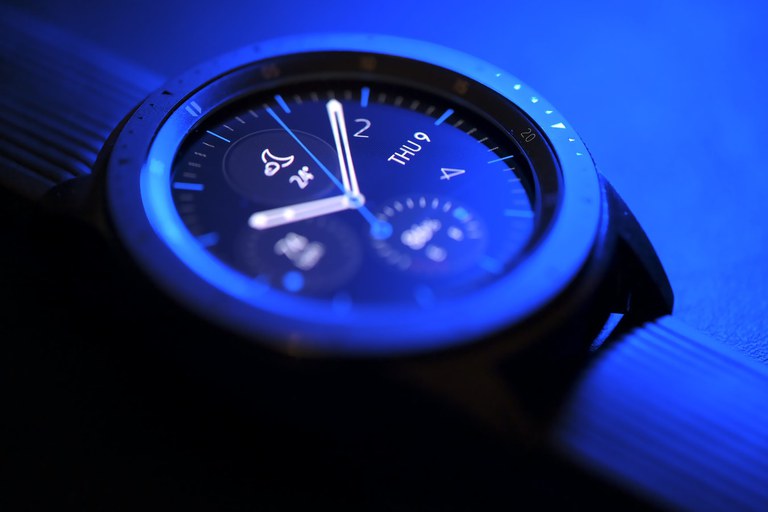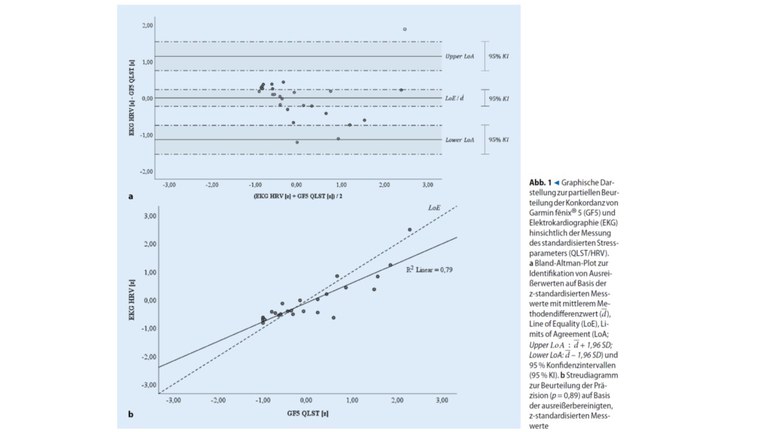
Wearable Devices im Sport
10 November 2020
Wearable Devices versprechen durch ihre motivierende Wirkung einen wichtigen Beitrag zur Bindung des Individuums an körperlich-sportliche Aktivitäten und somit zum Aufbau und Erhalt von Gesundheit und Leistungsfähigkeit in Zeiten des digitalen gesellschaftlichen Wandels. Übergeordnetes Ziel der vorliegenden Untersuchung war die Beurteilung der Testgüte von Wearable Devices anhand eines marktrelevanten Gerätes, der Garmin fēnix® 5. Als Forschungsdesiderat wurde der Reliabilitätsaspekt der Methodenkonkordanz identifiziert. Zur Überprüfung der Methodenkonkordanz wurden das Stresslevel bei kognitiver Stressinduktion, der Kalorienverbrauch bei moderater Ausdauerlaufbelastung sowie die maximale Sauerstoffaufnahme bei Laufausbelastung von 30 männlichen Probanden (Alter: 23,13±2,5 Jahre; BMI: 24,95±2,45 kg/m²) mit der Garmin fēnix® 5 bestimmt und die Ergebnisse mit denen im Feld gängigen Referenzmethoden Elektrokardiographie, Indirekte Kalorimetrie bzw. Spiroergometrie verglichen. Zur rechnerischen Überprüfung der Methodenkonkordanz diente Lin`s Konkordanzkorrelationskoeffizient (CCCLin). Die Ergebnisse zeigen eine hohe Präzision der Garmin fēnix® 5 im Vergleich mit der Referenzmethode Elektrokardiographie hinsichtlich der Messung des notwendigerweise z-standardisierten Stressparameters (p=0,89) sowie eine gerade mittlere exakte intrainidividuelle Konkordanz mit der Referenzmethode Indirekte Kalorimetrie bzw. Spiroergometrie hinsichtlich der Messung des Parameters Kalorienverbrauch (CCCLin=0,43 [p=0,52, Cb=0,82]) bzw. maximale Sauerstoffaufnahme (CCCLin=0,50 [p=0,77, Cb=0,66]). Die Garmin fēnix® 5 kann somit zumindest bei erstmaliger Verwendung nicht als hinreichend konkordante Alternative zu den gängigen aktivitäts- und leistungsbezogenen Referenzmethoden empfohlen werden.
In view of their motivating effect, wearable devices promise to provide an important contribution to individual`s maintenance of physical activity and thus, to the strengthening of health- and performance-relevant parameters in times of digital change. The overall aim of the present study was to evaluate the psychometric properties of wearable devices using a strong selling product of one of the markets key-players, the Garmin fēnix® 5. The reliability aspect of method concordance was identified as a research desideratum. To evaluate method concordance, stress level under cognitive stress exposure, energy expenditure during moderate running as well as maximum oxygen uptake during running of 30 male participants (age: 23.13±2.5 years; BMI: 24.95±2.45 kg/m²) as measured by the Garmin fēnix® 5 was compared with these parameters on the basis of the commonly accepted reference methods electrocardiography, indirect calorimetry and spiroergometry using Lin`s Concordance Correlation Coefficient (CCCLin). Following our results, the Garmin fēnix® 5 does provide a high precision when compared to the reference method electrocardiography and with regard to the measurement of the necessarily z-standardized stress parameter (p=0.89). Moreover, indications for just moderate exact intraindividual concordance between the Garmin fēnix® 5 and its respective reference method indirect calorimetry and spiroergometry regarding the parameters energy expenditure (CCCLin=0.43 [p=0.52, Cb=0.82]) and maximum oxygen uptake (CCCLin=0.50 [p=0.77, Cb=0.66]) were found. Therefore, the Garmin fēnix® 5 cannot be recommended as a sufficiently concordant alternative to the established activity- and performance-related reference methods, at least when used for the first time.





